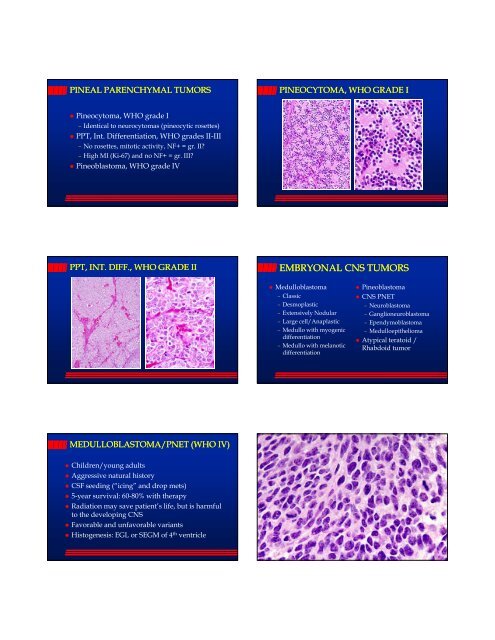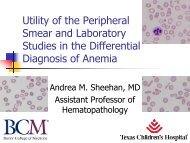GANGLIOGLIOMA (WHO I) GANGLIOGLIOMA (WHO I)
GANGLIOGLIOMA (WHO I) GANGLIOGLIOMA (WHO I)
GANGLIOGLIOMA (WHO I) GANGLIOGLIOMA (WHO I)
You also want an ePaper? Increase the reach of your titles
YUMPU automatically turns print PDFs into web optimized ePapers that Google loves.
PINEAL PARENCHYMAL TUMORS<br />
� Pineocytoma, <strong>WHO</strong> grade I<br />
– Identical to neurocytomas (pineocytic rosettes)<br />
� PPT, Int. Differentiation, <strong>WHO</strong> grades II-III<br />
– No rosettes, mitotic activity, NF+ = gr. II?<br />
– High MI (Ki-67) and no NF+ = gr. III?<br />
� Pineoblastoma, <strong>WHO</strong> grade IV<br />
PINEOCYTOMA, <strong>WHO</strong> GRADE I<br />
PPT, INT. DIFF., <strong>WHO</strong> GRADE II EMBRYONAL CNS TUMORS<br />
MEDULLOBLASTOMA/PNET (<strong>WHO</strong> IV)<br />
� Children/young adults<br />
� Aggressive natural history<br />
� CSF seeding (“icing” and drop mets)<br />
�� 5-year 5 year survival: 60-80% 60 80% with therapy<br />
� Radiation may save patient’s life, but is harmful<br />
to the developing CNS<br />
� Favorable and unfavorable variants<br />
� Histogenesis: EGL or SEGM of 4th ventricle<br />
� Medulloblastoma<br />
– Classic<br />
– Desmoplastic<br />
– Extensively Nodular<br />
– L Large cell/Anaplastic<br />
ll/A l ti<br />
– Medullo with myogenic<br />
differentiation<br />
– Medullo with melanotic<br />
differentiation<br />
� Pineoblastoma<br />
� CNS PNET<br />
– Neuroblastoma<br />
– Ganglioneuroblastoma<br />
– Ependymoblastoma<br />
– Medulloepithelioma<br />
� Atypical teratoid /<br />
Rhabdoid tumor



